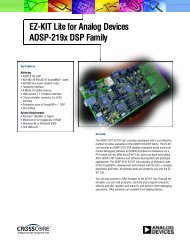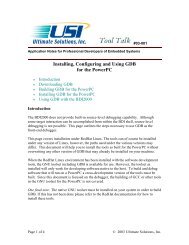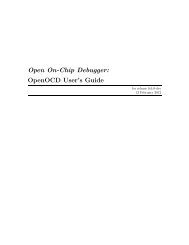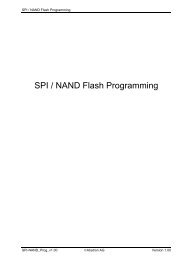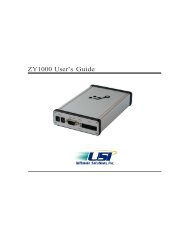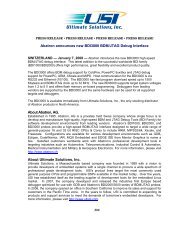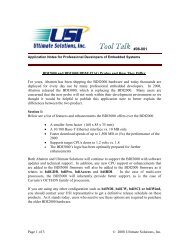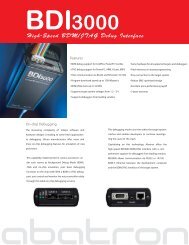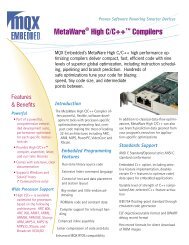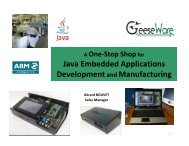STM32 Journal - Digikey
STM32 Journal - Digikey
STM32 Journal - Digikey
Create successful ePaper yourself
Turn your PDF publications into a flip-book with our unique Google optimized e-Paper software.
<strong>STM32</strong> <strong>Journal</strong><br />
consideration that the GUI may<br />
need to be redesigned several<br />
times. The sooner accurate user<br />
feedback can be incorporated<br />
into the GUI design, the more<br />
confidence developers can<br />
have that major changes will<br />
not be required after significant<br />
engineering resources have<br />
been invested in implementing<br />
the design.<br />
GUI Testing<br />
The iterative aspect of GUI design<br />
is an important consideration when<br />
selecting a GUI toolset. The speed<br />
and ease with which developers<br />
can modify an existing GUI will<br />
determine how many design<br />
iterations the schedule will allow<br />
and, consequently, how well the GUI<br />
will capture actual user behaviors.<br />
Any testing process needs to<br />
enable stakeholders and endusers<br />
to provide timely input<br />
into GUI design, preferably<br />
as early in the design cycle<br />
as possible. This means that<br />
developers need access to rapid<br />
prototyping capabilities before<br />
target hardware is available. The<br />
testing process should facilitate<br />
the capture of user behaviors<br />
and generation of use cases.<br />
To achieve this, GUI tools must<br />
accelerate design to shorten the<br />
time between test iterations.<br />
Traditionally, developers have<br />
created simulated environments<br />
for users to test. Often these<br />
“wireframe” simulators are<br />
independent tools that allow<br />
developers to put together a<br />
GUI but not necessarily one that<br />
accurately reflects how the final<br />
product will look or operate. For<br />
example, because the simulator<br />
is running on a high-speed<br />
PC, screen updates can be<br />
near instantaneous. Unless the<br />
simulator is able to emulate the<br />
MCU that will be used in the actual<br />
product, developers will be unable<br />
to verify whether the system is<br />
responsive enough to satisfy users.<br />
In fact, feedback from such testing<br />
may actually mislead developers<br />
and result in launch delays.<br />
To ensure that the simulator<br />
matches how the interface will<br />
operate in production hardware<br />
as accurately as possible, the<br />
simulator needs to emulate the<br />
operation of the target MCU.<br />
Developing an embedded GUI<br />
on a PC capable of accurate<br />
emulation offers several benefits<br />
to developers (see Figure 2). In<br />
addition to speeding testing by<br />
eliminating the need to download<br />
new firmware to a target, the<br />
simulator provides several<br />
analysis capabilities to facilitate<br />
optimization and debugging:<br />
Figure 2 GUI design tools like the IS2T MicroEJ® simulator that is part of GWPack from<br />
GeeseWare emulate the target MCU to ensure consumer testing matches the<br />
operation of the production GUI as closely as possible.<br />
〉〉 Static and run-time analysis of<br />
timing and memory footprint<br />
〉〉 Functional code coverage<br />
〉〉 Task profiling and scheduling<br />
Ideally, testers need to have<br />
as realistic an experience as<br />
possible. This means working<br />
on a small screen the same size<br />
as the one that will be used for<br />
production. When running on a<br />
PC, the user may need to use<br />
a mouse rather than be able to<br />
touch the device screen. Even if<br />
a touchscreen is available, it is<br />
likely the wrong size or a monitor<br />
that the user cannot hold in his<br />
or her hand.<br />
To enable realistic testing,<br />
GeeseWare offers its GWPack<br />
development system. The<br />
GWPack includes a standalone<br />
and small form factor board<br />
based on either the <strong>STM32</strong>-F2<br />
or <strong>STM32</strong>-F4 that is prequalified<br />
and production-ready. With a 4.3”<br />
resistive or capacitive touchscreen,<br />
10 ms response time, and access<br />
in Java to all of the <strong>STM32</strong><br />
architectures peripherals and<br />
interfaces of the pack, the GWPack<br />
gives developers a fully operational<br />
Java platform upon which to carry<br />
applications from proof-of-concept<br />
to production faster than has been<br />
possible before.<br />
45




